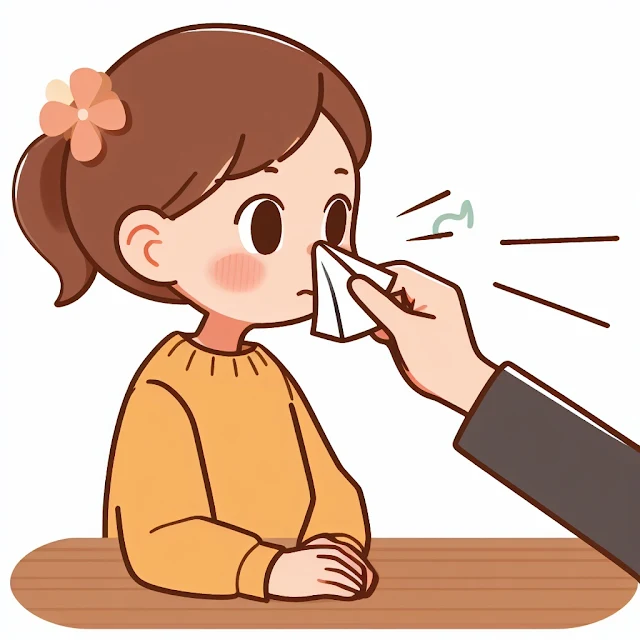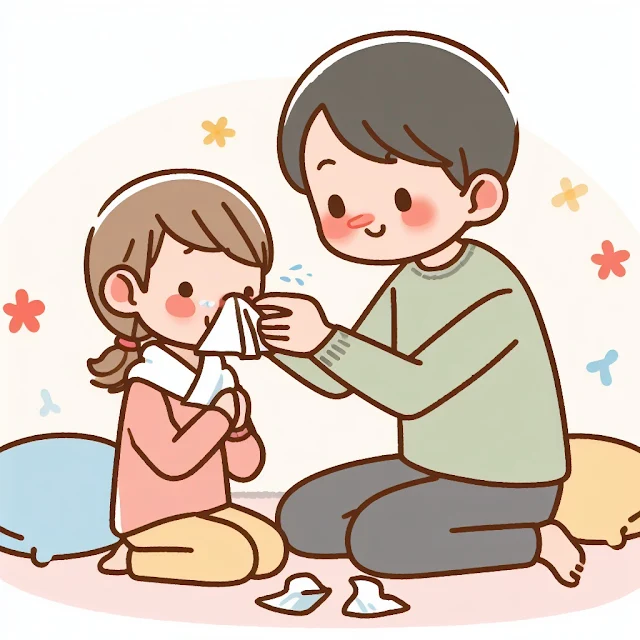Mastering the Mucus: A Comprehensive Guide to Teaching Kids to Blow Their Nose
Let's talk about something that's not so pleasant but oh-so-essential: nose-blowing. As parents, we've all been there – the sniffles, the sneezes, the endless supply of tissues. And then there's the challenge of teaching our little ones how to blow their noses properly.
It can be a messy, frustrating experience, but it's one that we've got to conquer for the sake of their health and hygiene.
Why is nose-blowing so important, you ask? Well, mucus is our body's natural defense against germs and irritants. It traps dust, dirt, and viruses, preventing them from entering our lungs. But when mucus builds up, it can lead to congestion, discomfort, and even infections.
So, teaching our kids to blow their noses regularly is like giving them a tiny superpower – the power to protect their little bodies from the nasties of the world.
Understanding the Basics
Before we dive into the nitty-gritty of nose-blowing techniques, let's take a moment to understand why mucus is so important and why it can be tricky for kids to blow their noses.
The Mucus Mystery
Imagine your nose as a tiny filter. As we breathe, air rushes through our nostrils, and along the way, it picks up all sorts of tiny particles, from dust and dirt to pollen and viruses.
Mucus, that sticky stuff that sometimes makes us sniffle, is like a sticky net that catches these invaders, preventing them from reaching our lungs.
Developmental Dilemmas
So, why do kids have such a hard time blowing their noses? Well, it's all about coordination and development. The muscles around the nose and mouth need to work together in a specific way to blow air out the nose, and this coordination takes time to develop.
For example, think of blowing a balloon. You need to take a deep breath, close your mouth, and force air out through your lips. It's a similar concept to blowing your nose, but instead of using your lips, you're using your nostrils.
Common Challenges
Here are some common reasons why kids might struggle with nose-blowing:
- Age: Most kids don't master nose blowing until they are around 4 or 5 years old.
- Congestion: When the nose is stuffy, it can be even harder to blow air out.
- Lack of understanding: Kids might not understand the purpose of blowing their nose or how to do it properly.
- Sensory issues: Some kids might be sensitive to the feeling of tissues on their nose or the sensation of air blowing out.
Patience and Positivity
The key to teaching your child to blow their nose is patience and positivity. Remember, it's a new skill that takes time and practice.
Don't get discouraged if they don't get it right away. Just keep practicing and providing plenty of praise and encouragement.
Step-by-Step Guide to Nose-Blowing Mastery
Now that we've demystified mucus and understood the challenges, let's get down to the business of teaching your little one the art of nose-blowing.
Setting the Stage
Before you embark on this nose-blowing adventure, make sure the environment is conducive to learning. Here are a few tips to set the stage for success:
- Choose a calm and distraction-free spot. Avoid teaching your child to blow their nose when they're sick or upset.
- Gather your supplies. Have soft tissues, a mirror (optional), and some fun rewards handy.
- Make it fun and engaging. Turn nose-blowing into a game or use silly songs and rhymes to keep your child motivated.
Step 1: Mouth Blowing Basics
Before diving into nose-blowing, let's start with something more familiar – blowing with the mouth. This helps your child understand the concept of blowing air out.
- Have your child hold a tissue to their nose.
- Instruct them to take a deep breath and blow air out of their mouth.
- Encourage them to blow hard enough to make the tissue move.
Step 2: Introducing Nose Blowing
Now that they've mastered mouth-blowing, it's time to transition to nose-blowing.
- Have your child take a deep breath and close their mouth.
- Gently pinch one nostril and instruct them to blow air out through the other nostril.
- Encourage them to blow forcefully but gently.
- Repeat the process on the other side.
Step 3: Refining Technique
With a little practice, your child will start to get the hang of it. Here are some tips to refine their technique:
- Remind them to keep their mouth closed throughout the process.
- Encourage them to blow forcefully enough to expel mucus effectively.
- Teach them to dispose of used tissues properly.
Step 4: Making it a Habit
Remember, nose-blowing is a skill that takes time and practice. Encourage your child to practice regularly, especially when they're sick or have a runny nose.
With patience and persistence, they'll soon become nose-blowing experts!
Additional Tips and Tricks for Nose-Blowing Success
While the step-by-step guide provides a solid foundation, here are some additional tips and tricks to make nose-blowing a breeze for your little one:
1. Gamify the Process
Transform nose-blowing into a fun-filled game. Create a competition to see who can blow their nose the farthest or make the loudest blowing sound.
Use silly props like animal masks or superhero capes to add a touch of excitement.
2. Visual Aids for the Win
Utilize visual aids to make the concept of nose-blowing more tangible. Use flashcards with pictures of different facial expressions, such as blowing a balloon, blowing bubbles, or blowing out candles.
You can also use puppets or stuffed animals to demonstrate the technique.
3. Positive Reinforcement is Key
Celebrate every small victory, no matter how insignificant it may seem. Offer verbal praise, stickers, or small treats as rewards for progress. Positive reinforcement will boost your child's confidence and encourage them to keep practicing.
4. Be Patient and Understanding
Learning a new skill takes time and patience. Don't get discouraged if your child doesn't master nose-blowing overnight. Be understanding, supportive, and consistent in your approach.
5. Make it a Routine
Incorporate nose-blowing into your child's daily routine. Encourage them to blow their nose after meals, before bedtime, and whenever they feel congested.
This will help them develop a habit and make nose-blowing a natural part of their hygiene practices.
Frequently Asked Questions (FAQ)
At what age should I start teaching my child to blow their nose?
Most children begin to master nose-blowing between the ages of 4 and 5. However, you can start introducing the concept earlier by practicing mouth-blowing with them.
Why does my child struggle to blow their nose?
There are several reasons why children might struggle with nose-blowing. Some common reasons include:
- Age: Nose blowing requires fine motor coordination that develops over time.
- Congestion: When the nose is stuffy, it can be harder to blow air out.
- Lack of understanding: Children might not understand the purpose of blowing their nose or how to do it properly.
- Sensory issues: Some children might be sensitive to the feeling of tissues on their nose or the sensation of air blowing out.
How can I make nose-blowing more fun for my child?
Here are some tips for making nose-blowing more fun and engaging:
- Gamify the process: Turn nose-blowing into a game or competition.
- Use visual aids: Use flashcards, puppets, or stuffed animals to demonstrate the technique.
- Make it a routine: Encourage your child to blow their nose after meals, before bedtime, and whenever they feel congested.
What should I do if my child refuses to blow their nose?
If your child refuses to blow their nose, try the following:
- Be patient and understanding: Don't force your child to blow their nose. Instead, try to understand why they're resisting and address their concerns.
- Offer rewards: Positive reinforcement can be a powerful motivator. Offer stickers, small treats, or praise for progress.
- Make it a family affair: Encourage everyone in the family to blow their nose regularly. This will help your child see that it's a normal and important part of hygiene.
How can I help my child develop good hygiene habits?
Here are some general tips for helping your child develop good hygiene habits:
- Start early: Introduce good hygiene habits from a young age.
- Make it fun and engaging: Use songs, games, and stories to make hygiene practices more enjoyable.
- Be a good role model: Children learn by watching the adults in their lives. Model good hygiene habits yourself.
- Encourage independence: As your child gets older, encourage them to take responsibility for their own hygiene.
Final Thoughts
Congratulations! You've successfully tackled the nose-blowing challenge!
Remember, patience, positivity, and plenty of practice are the keys to mastering this important skill. With your guidance and support, your little one will soon be blowing their nose like a pro!
Do you have any additional tips or tricks for teaching children to blow their nose? Share your experiences in the comments below!


